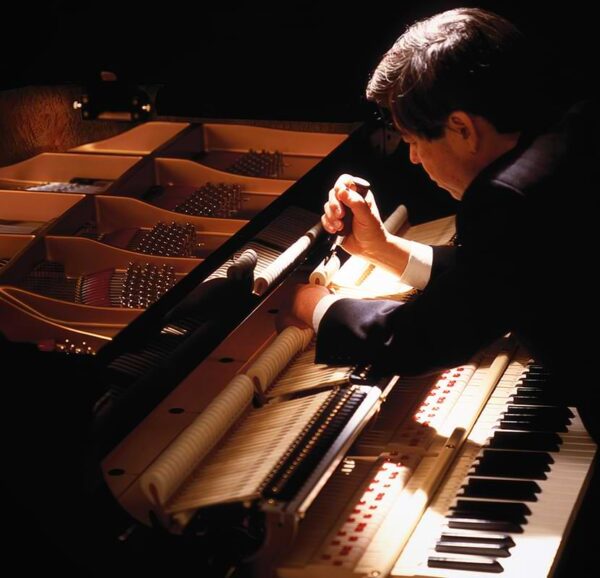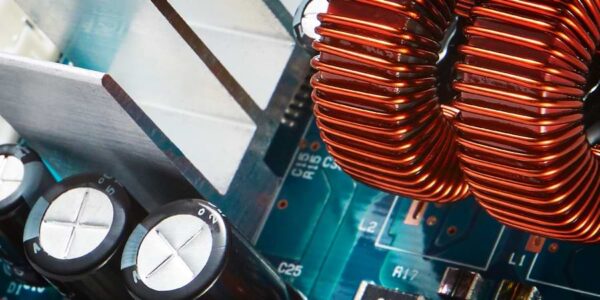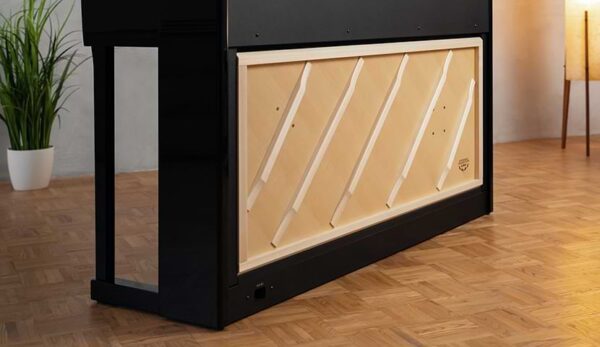PART III: PIANO REALISM
The last two articles have explored the various Kawai actions and sound technologies. Touch and tone are paramount to any piano, digital or acoustic, so it made sense to cover the basics first. This article will focus on two features that bolster touch and tone. The first feature is the Virtual Piano Artisan (or Virtual Technician) which allows the user to shape the piano to their liking. The second is the speaker system, which is as vital to the instrument as the sound being played through it.VIRTUAL PIANO ARTISAN / TECHNICIAN

The knowledge and skill of an experienced piano technician is essential to bring out the best of a fine acoustic piano. In addition to tuning each note, the technician also performs numerous regulation and voicing adjustments that can profoundly change the character of the piano. Kawai’s powerful Virtual Piano Artisan and Virtual Technician simulate the refinements a skilled piano technician can perform, allowing discerning musicians to shape aspects of the piano’s character to suit their personal preferences.
The Virtual Piano Artisan is Kawai’s newest iteration of the Virtual Technician. Either one or the other can be found on all Kawai digital pianos. They all have ‘smart’ presets that can be selected to alter the piano sound in significant ways. The more advanced models come with the ability to change individual parameters to suit one’s needs. The more advanced the model, the more individual parameters are available. Here is the full list of individual parameters.
- Touch Curve
- adjusts the relationship between volume and the strength of keystrokes
- Voicing
- simulates different hammer properties that affect the tonal character of the piano
- Damper Resonance
- is the added resonance of unstruck strings when the damper pedal is engaged
- Damper Noise
- is the noise made by the damper pedal when it is pressed
- String Resonance
- simulates the interplay between undampened strings (notes being played)
- Undamped String Resonance
- recreates the resonance of the unfelted topmost strings
- Cabinet Resonance
- simulates the cabinet resonance of a grand piano
- Key-off Effect
- simulates the sound of the dampers touching the strings immediately before the sound stops
- Fall-back Noise
- is the sound the action makes when the key is released
- Hammer Noise
- adjust the sound of the hammers hitting strings and the keys hitting the key bed
- Hammer Delay
- adjusts the slight delay of the hammers hitting strings when acoustic pianos are played in pianissimo
- Topboard Simulation
- simulates the difference in the sound produced as a result of lid position
- Decay time
- adjusts the duration of the sound decay after keys are pressed
- Release Time
- changes the duration of the sound decay after keys are released
- Minimum Touch
- adjusts the touch sensitivity for the quietest sound
- Stretch Tuning
- allows the user to alter the tuning intervals between notes
- Temperament
- provides various common and historical tuning systems
- Temperament Key
- adjusts the selected temperament to a specified tonic
- Key Volume
- allows players to adjust the volume of each of the 88 keys
- Half-pedal Adjust
- adjusts the point at which the damper pedal becomes effective
- Soft-pedal Depth
- alters the intensity of the soft pedal
SPEAKER SYSTEMS

The saying goes, “a chain is only as strong as its weakest link.” You can have an otherwise fantastic digital piano, but if the speaker system is sub-par, it won’t be enjoyable to play. In fact, a bad-sounding piano can be a hinderance to the learning process. Picture someone walking on a rocky shoreline, slowly and carefully placing each foot as to avoid sharp rocks. Now imagine that same person walking that same way down a sidewalk. Aside from looking silly, they would be moving with slow, unnecessary movements. Learning to play piano on a bad-sounding one is like learning to walk on a rocky shore. The repetitive nature of practicing piano is meant to imprint good technique through muscle memory. It stands to reason that practicing on a bad piano will reinforce bad technique over time.

Kawai prides itself on the sound of its digital pianos, creating instruments that anyone can play dynamically on. Their entry-level pianos use full range speakers, meaning that they account for the entire sound of the digital piano. These speakers are matched with drivers ranging from 18W to 40W. I say matched because there needs to be a balance struck between the speaker and the driver so that low frequencies are substantial, high frequencies are clear, and sound won’t distort when played at full volume. Kawai does an excellent job of matching their speakers with drivers and it’s a big reason why they can be played so expressively.
More substantial speaker systems can be found on Kawai’s mid-level digitals. They all have ‘woofers’ which are speakers specifically designed to handle the lower frequencies. They also have speakers dedicated to the mid and high frequencies. Some of them employ 360o diffusers to widen the distribution of sound, creating a more authentic experience. The DG-30 has 2 unique, soundboard-mounted speakers that emulate the sound projection of a grand piano.
Partnering with Onkyo

Kawai’s high-end digitals and hybrids use special components developed in collaboration with Onkyo, one of Japan’s leading premium audio manufacturers. Cutting edge technologies such as 1-bit processing, dual DAC conversion and Onkyo’s DIRDC filtering help to reproduce acoustic piano sounds with spectacular clarity, richness, and power. These digital pianos also utilize a high performance Discrete SpectraModule™ headphone amplifier to ensure the finest quality listening experience, even when playing in privacy.
TwinDrive Soundboard Speaker System

Featured on the CA-901 and Novus NV-5 is Kawai’s TwinDrive Soundboard Speaker System. This unique audio technology embraces the rich, harmonic qualities of wood by using transducers to channel sound energy onto a large soundboard in order to produce a more natural, organic tone. Long wooden ribs are securely attached to the soundboard to further broaden the frequency range and volume of the resonating sound, resulting in a remarkably authentic playing experience that faithfully reproduces the tonal ambience of an acoustic piano.
The TwinDrive system represents the third generation of Kawai’s soundboard technology, and features an improved primary transducer redesigned to deliver more power and volume. In addition, a secondary transducer, mounted towards the treble end of the instrument, helps to further expand the tonal range produced by the soundboard beyond the existing low frequencies, allowing mid-low and even mid-high ranges to also benefit from the warming, acoustic properties of wood.
| KAWAI SPEAKER SYSTEMS | ||
|---|---|---|
| Instrument | Speakers | Output Power |
| Novus NV-10* |
dome tweeters x2
top speakers x4 woofer |
130W |
| Novus NV-5* | TwinDrive Soundboard Speaker System plus…
dome speakers x2 top speakers x4 |
130W |
| CA-901* | TwinDrive Soundboard Speaker System plus…
top speakers with diffuser front speakers x2 tweeters x2 |
135W |
| CA-701 |
woofers x2
top speakers with diffusers x2 tweeters x2 |
110W |
| CA-501 |
woofers x2
top speakers with diffusers x2 |
100W |
| DG-30* |
woofers x2
top speakers x2 |
40W |
| CN-301 |
woofers x2
top speakers with diffusers x2 |
40W |
| CN-201 | full range speakers x2 | 40W |
| KDP-120 | full range speakers x2 | 40W |
| KDP-75 | full range speakers x2 | 18W |
| ES-920 | full range speakers x2 | 40W |
| ES-520 | full range speakers x2 | 40W |
| ES-120 | full range speakers x2 | 20W |
Kawai’s Grand Pianos In Depth
With approximately 9,000 moving parts, the piano may be the most complicated acoustic instrument ever built. There are dozens of components that must work in
Kawai’s Digitals: Part 5 – The Rest
PART V: THE REST Beyond simply being played as an instrument, digital pianos have other features that can enhance the musical experience. With built-in lesson
Kawai’s Digitals: Part 4 – Connectivity
PART IV: CONNECTIVITY The ability to connect with technology is one of the advantages of a digital piano. From using your piano as a Bluetooth
Kawai’s Digitals: Part 3 – Piano Realism
PART III: PIANO REALISM The last two articles have explored the various Kawai actions and sound technologies. Touch and tone are paramount to any piano,
Kawai’s Digitals: Part 1 – Actions
PART I: DIGITAL PIANO ACTIONS The importance of a digital piano’s action cannot be understated. The ability to play dynamically is what makes a piano
Kawai’s Digitals: Part 2 – Sound Technology
PART II: SOUND TECHNOLOGY Playing a piano can be a rewarding experience. The slightest change of pressure applied to a key not only affects the
Kawai’s Upright Pianos In Depth
To put pianos into perspective, an average automobile engine has around 300 parts, a violin has 90, a microscope has 14, and a piano has
Kawai Digital Comparison Chart
Digital pianos are always evolving. Kawai makes a real effort to advance the realism of digital pianos. Though their work is impressive and exciting, it

